
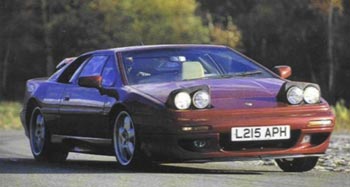
Lotus Esprit S4
Road test
There is going to be a burial at Lotus's Norfolk headquarters any day now. It will not be a large event, there will be no Nikon-clicking paparazzi in attendance. Mourners will be few. just a dignified clump of staff congregating in a corner of the grounds to watch Patrick Peal, head of public affairs, dig a small hole in the turf and commit to earth the last ever Morris Marina door handle to insult the flank of the Lotus Esprit. Once the hole has been filled in, doubtless he will do a little dance.
This, you understand, is no morbid ritual, but a symbolic celebration of the day when common sense swept, tornado-like, through the 17-year-old supercar to produce this, the S4, the first street-wise Esprit. Inside and out there are revisions aplenty for you to see. What is not immediately apparent is how far beneath the surface that common sense has penetrated. For now, content yourself with the knowledge that the S4 drives like no other Esprit in history and the reason why goes far, far beyond the adoption of power steering and bigger wheels.
Many of the more visible changes are easy to see. The bodywork at ground level is all new, with a revised front chin incorporating new foglights, rakishly scooped side skirts and an all-new rear Valance. Higher up the car there is a revised rear spoiler and a fresh rear panel. Most noticeable of all, though, is the deletion of the massive, ungainly rear wing and the arrival of a smaller, less blatant item which, mounted on the swoop down from the roof, nevertheless still manages to pollute design chief julian Thomson's otherwise effective update of the Lotus's ageing but enduringly striking shape.
However it is those changes that are not obvious from a hundred paces which make the most difference to the Esprit and its driver; the now safely interred Marina door handle is just the most obvious of these.
For the price of little more than a long overdue raid on the parts bin of daddy General Motors, Lotus has once and for all dealt the death blow to the Esprit's glorified kit-car image. The ghastly British Leyland column stalks, nasty electric window and mirror switches and the need for a bunch of keys just to get in and drive away are all nightmares of the past.
One key now fits all and a twist of the lock by the smart colour-coded handle activates deadlocks, an alarm and an immobiliser. Soft, slick—looking switches now operate windows and mirrors and the tacky wood veneer that housed the instruments has been replaced by a grey carbon-fibre lookalike surround. Who'd have thought it of an Esprit?
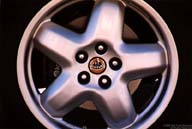
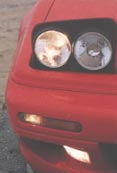
More to the point, who'd have thought an Esprit needed power steering? Its steering was the one area of endeavour in which the out-going Esprit SE could scarcely be criticised. Over to Roger Becker, director of vehicle engineering and the man behind the S4. Becker wanted to - sharpen up - the Esprit and is the first to admit the chassis was too soft. “We engineered understeer into the old Esprit to keep its handling safe but, to be honest, we overstepped the mark. For the S4 we wanted quicker responses, a neutral to oversteer handling balance, less roll and more grip.To achieve this without, at the same time introducing an element of nervousness, we spent two years developing power steering with Saginaw [a GM outpost]”
To achieve all this, Becker and colleagues went through the suspension in minute detail. Lotus-designed 17ins wheels were commissioned along with purpose-built Goodyear GSA tyres. With 245/45s at the rear and 215/40s up front they make traditional low-profile rubber look like tractor tyres.
At the front, the geometry was changed from a pro-dive condition to one of zero dive, the anti-roll bar was thinned, caster and negative camber increased and spring rates upped by 24 per cent. There's more camber at the rear, too, and springs fully 44 per cent stiffer. If nothing else, the Esprit S4 is guaranteed to roll less.
Becker rightly considered the 264bhp pumped out by the existing twin-cam turbo four was sufficient, especially as he had no desire to tread on the toes of the forthcoming, 300bhp Sport 300 Esprit. So, save a reprogrammed chip that is claimed to improve bottom-end response, the engine is unchanged (the 215bhp turbo unit has been dropped). The gearbox remains, too, complete with existing ratios, but the linkage has been improved resulting in a snappier change with a shorter throw.
I'm not sure whether the S4 interior's stab at style or the ease with which you can now squeeze the car out of a tight spot that made the difference, but there is no doubt that I initially felt better disposed towards this Esprit than any other in memory. In the past they had always been brooding, unfriendly creatures that took hundreds of miles on open roads before slowly sneaking their way into my affections.


With the S4, however, I had neither the time nor the weather for such a trip. I had no choice but to climb aboard and gingerly head out on to Lotus's private race track.
It is quite something to find yourself on a drenched and unfamiliar track in someone else's £46,995 mid-engined supercar armed only with the knowledge that it has been designed to oversteer.
I had forgotten just how fast the Esprit is these days. In acceleration the S4 is at least a league ahead of the likes of the Porsche Carrera 2, Ferrari 348 and Honda NSX. One whiff of a straight and the Esprit hits 125mph with no more than three flicks of the markedly more co-operative 'box.
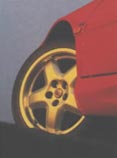
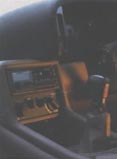
That this crucial part of the Esprit's character remains is great news but it's corners that bring the changes. Where once it would be all you could do to stop it running straight on, now it turns obediently on your command and, as it does, the chunky new steering wheel lightens up just a shade, letting you know the tyres are near the limit. As promised though, oversteer awaits.
It comes in two varieties. The first is achieved simply by modulating the throttle mid-corner to tighten your line. This is a delicious process with the car reacting fast enough to be effective but without being frightening. Steering has lost a sizeable slice of the feel that so distinguished its unassisted forebear, but retains enough to argue the toss with the Porsche 968 over whose is the most communicative power steering in the business.
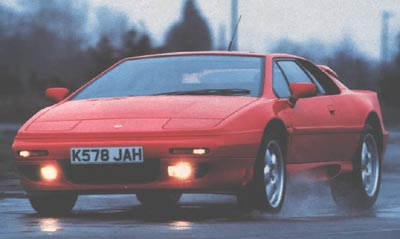
The second lot of oversteer results from the time-honoured technique of reaching the apex of a corner and treading hard on the accelerator. In the wet at least, the slide is sharp but not savage. True, you have to be quick with the correction, but if you are, the steering will round up the runaway tail as surely as a lasso around a colt's neck. Understeer only enters the equation when you need it, acting as a stabilising influence in very fast curves.
After 20 laps, I left the track by the conventional route and with an entirely new impression of the Esprit. As I headed out into the Norfolk lanes, I began to think that the S4 was a car which, far from requiring a list of qualifying comments, could be a car which need apologise to no one.
A few real-world bumps brought me back down to earth. The revised suspension has done wonders for handling, but the superb ride quality that came with the softer springs has gone. The ride is now merely reasonable, the master of the 348 and Carrera 2 for sure but no longer a match for the NSX. And the engine has never come close to the sublime power-plants sported by these fiercest of rivals. New chip or not, it does not feel any different: it still sounds undistinguished at low revs and boorish at speed. The new tyres are noisy and the brakes, unchanged, are only adequate and can still fade in the face of prolonged hard work.
Yes you can still pick holes in the Esprit's case, especially for lack of legroom, pronounced wind noise and small (though thoughtfully repositioned) instruments. The ventilation controls are lamentable, too. What you cannot do any more is write it off as an outmoded no-hoper. Indeed, it is not so much the car the Esprit should always have been, rather it is again the car it once was a decade or more ago.
Back then the Esprit strode into battle against the Ferrari 308 without so much as a backward glance. I don't doubt that a 348, slower and more treacherous at the limit though it is, makes you feel more special.
For an extra £27,000 so it should. Nor could you argue for long that this Esprit is a better car than a Honda NSX. That is patently not the case.
But for the 300 people worldwide who Lotus hopes intend to own an S4 by the end of this year the news is better than I ever expected. Many will happily write the cheque expecting no more than a car with arresting looks and a badge on the front which still evokes more warm memories than all save those bearing a prancing horse. They will be surprised and delighted, then, when they realise they have also bought not just a mightily effective supercar but one which still understands better than most the difference between speed and fun. This much is certain: the Esprit is back and this time it's apologising to no one.
|
Production Figures There were a total of 622 Lotus Esprit S4 models built over a 4 year span. The breakdown by year is as follows.
In 1994, there were 3 different Esprit models built by Lotus, totalling 370. The S4, the S4s, and the Sport300. The Sport300 was only availble in the UK, and the S4s was likely a prototype, as there was only one built. Heres the complete breakdown for
|
TECHNICAL SPECIFICATION
How
fast (claimed)
0-60mph 4.7secs
Top speed 165mph
How
much?
£46995
Engine
Max power: 264bhp/6500rpm
Max torque: 261 lb ft/3900rpm
Power to weight: 232bhp/tonne
Capacity: 2174cc. 4 cyls in line
Bore/stroke: 95mm/76mm
Compression ratio: 8.0:1
Valves: 4 per cyl, dohc
Ignition and fuel: electronic Ignition and fuel injection, chargecooled
turbo
Gearbox
Type: 5-speed manual
Ratios:
1st 3.36
2nd 2.05
3rd 1.38
4th 1.03
5th 0.82
Final drive 3.89
Suspension:
Front double wishbones. anti-roll bar
Rear trailing radius arms, anti-roll bar
Steering:
power-assisted rack and pinion
Lock to lock 3.1 turns
Brakes:
Front 259mm ventilated discs
Rear - 274mm solid discs Anti-lock standard
Wheels:
Size 7x 17ins (f). 8.5x17ins (r)
Made of cast alloy
Tyres:
Goodyear GSA,
215/40ZR 17 (f).
245/45ZR 17(r)
Standard Equipment:
Full Connolly Leather interior, air conditioning, power windows and door locks,
electrically operated fuel filler flaps, heated and electrically operated
remote outside mirrors, delay safety interior lighting system, three phase
ice warning system, tinted glass. Primary safety equipment is three point
retractable safety belts and Supplemental Inflatable Restraints (airbag) contained
with a kevlar and aluminum passenger safety cell. AM/FM cassette receiver
with four matched speakers. Four-wheel anti-lock brakes (ABS) are standard.
Optional Equipment:
Metallic paint, 6-disc remote CD changer, removable transparent roof panel.
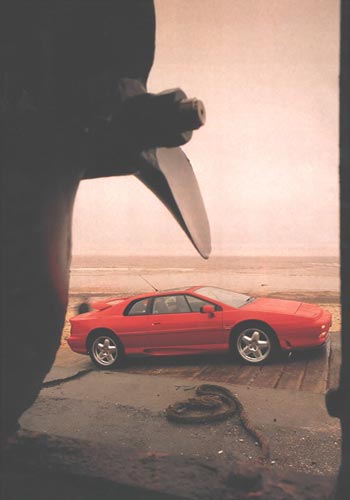
|
|